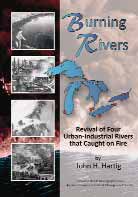SEJournal Online is the digital news magazine of the Society of Environmental Journalists. Learn more about SEJournal Online, including submission, subscription and advertising information.

BookShelf
Burning Rivers: Revival of Four Urban-Industrial Rivers That Caught on Fire
By John H. Hartig
Multi-Science Publishing Co., $35
Reviewed by TOM HENRY
Those familiar with how Lake Erie became one of the key inspirations for action after the first Earth Day in 1970 are all too familiar with the 1969 Cuyahoga River fire near downtown Cleveland. It became one of the region’s greatest symbols of neglect for future generations.
But what a lot of people don’t realize is that the Cuyahoga was only one of at least four Great Lakes tributaries to catch fire, all because of their enormous pollution from industrialization. The other three were the Chicago, Buffalo and Rouge rivers, the latter near Detroit.
In Burning Rivers: Revival of Four Urban-Industrial Rivers That Caught on Fire, limnologist John Hartig gives the reader a historical overview of the four rivers and explains the warning signs of distress the oily pollution from each caused, mainly to fish and wildlife. The history of anything from DDT to the old canal system is included.
The book won a 2011 Green Book Festival Award and was a finalist in the “science/nature/environment” category of the 2011 Next Generation Indie Book Awards. Hartig now manages the Detroit River International Wildlife Refuge, the only wildlife refuge shared by the United States and Canada. Formerly an adjunct professor at Wayne State University, he has more than 30 years of experience in environmental science and natural resource management.
The lay audience may find some of the scientific findings a little difficult to wade through, but they’re not so cumbersome to detract from the book’s eye-opening value. It sheds light where light needed to be shed, even if the prose becomes a bit academic at times.
To many people, the legacy of Great Lakes pollution is centered around the guffaws on late-night talk shows years ago, when Cleveland earned the dubious “Mistake on the Lake” nickname in the aftermath of the Cuyahoga River’s fire.
Countless environmental regulators, governors and other dignitaries have for decades now used the Cuyahoga as their anecdote for the region’s story of its ruin and recovery.
But as Hartig’s book shows, the Cuyahoga was only part of the story. Mankind should never have degraded the world’s largest collection of fresh surface water the way it did.
Along the way, characters emerge such as Buffalo River advocate Stanley Spisiak, whose activism and fierce determination drew then-President Lyndon B. Johnson on Aug. 25, 1966 to Buffalo, where the president’s wife, Lady Bird Johnson, cut through the thought of any high-brow analysis of a river sample by calling it a “bucket of slop.”
Thanks to Hartig, there is a lengthy discussion about how the worst abuse — water fouled so thickly with pollution that it was capable of burning — went well beyond the Cleveland waterfront. Much of it was the result of poorly treated or untreated sewage, as well as heavy petrochemicals.
Hopefully, the odds of more burning rivers are unlikely since America’s landmark Clean Water Act of 1972 and the equally important Great Lakes Water Quality Agreement signed by former President Richard Nixon and former Prime Minister PierreTrudeau ushered in the modern era of sewage treatment and industrial pollution controls.
Tom Henry is an editorial writer and columnist for The (Toledo) Blade. He is a member of SEJ’s board of directors, on SEJournal’s editorial board and is SEJournal’s book editor.
* From the quarterly newsletter SEJournal, Winter 2011-12. Each new issue of SEJournal is available to members and subscribers only; find subscription information here or learn how to join SEJ. Past issues are archived for the public here.













 Advertisement
Advertisement 



